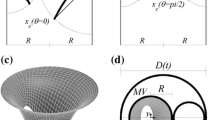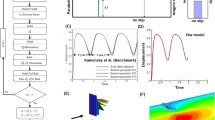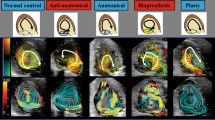Abstract
We analyzed intraventricular blood flow numerically to study the influence of the mode of mitral valve opening on the flow field in the left ventricle. Four different types of opening mode were examined: gradually axisymmetric, gradually anteroposterior (anatomical), gradually bilateral (anti-anatomical), or instantaneous opening and closing. In these models, the shape of the valve orifice was the same when the mitral valve was opened fully. The results demonstrated that the framework of the velocity profile of transmitral flow was built during the phase of mitral valve opening, which was characterized by the mode of valve opening. After the mitral valve opened completely, the transmitral velocity profile developed while maintaining its topological features. Consequently, each mode of mitral valve opening had its own pattern of intraventricular flow, although mitral valve opening accounted for less than 4% of a cardiac cycle. Particle tracking in the resulting flow field revealed that ventricular ejection was more efficient in the anteroposterior and axisymmetric opening modes. These results addressed the importance of the mode of mitral valve opening in intraventricular flow dynamics.











Similar content being viewed by others
REFERENCES
Aazami, M., and H. J. Schafers. Advances in heart valve surgery. J. Interv. Cardiol. 16:535–541, 2003.
Akutsu, T., and D. Higuchi. Effect of the mechanical prosthetic mono and bi-leaflet heart valve orientation on the flow field inside the simulated ventricle. J. Artif. Organs 3:126–135, 2000.
Akutsu, T., and D. Higuchi. Flow analysis of the bileaflet mechanical prosthetic heart valves using laser Doppler anemometer: Effect of the valve designs and installed orientations to the flow inside the simulated ventricle. J. Artif. Organs 4:113–112, 2001.
Akutsu, T., and T. Masuda. Three-dimensional flow analysis of a mechanical bileaflet mitral prosthesis. J. Artif. Organs 6:112–123, 2003.
Bellhouse, B. J. Fluid mechanics of a model mitral valve and left ventricle. Cardiovasc. Res. 6:199–210, 1972.
Butterfield, M., D. J. Wheatley, D. F. Williams, and J. Fisher. A new design for polyurethane heart valves. J. Heart Valve Dis. 10:105–110, 2001.
Domenichini, F., G. Pedrizzetti, and B. Baccani. Three-dimensional filling flow into a model left ventricle. J. Fluid Mech. 539:179–198, 2005.
Ebbers, T., L. Wigstrom, A. F. Bolger, B. Wranne, and M. Karlsson. Noninvasive measurement of time-varying three-dimensional relative pressure fields within the human heart. J. Biomech. Eng. 124:288–293, 2002.
Ellis, J. T., T. M. Wick, and A. P. Yoganathan. Prosthesis-induced hemolysis: mechanisms and quantification of shear stress. J. Heart Valve Dis. 7:376–386, 1998.
Gao, Z. B., N. Hosein, F. F. Dai, and N. H. Hwang. Pressure and flow fields in the hinge region of bileaflet mechanical heart valves. J. Heart Valve Dis. 8:197–205, 1999.
Iwase, H., H. Liu, S. Fujimoto, and R. Himeno. Computational modeling of left ventricle dynamics and flow based on ultrasonographic data. JSME Int. J. Ser. C 46:1321–1329, 2003.
Keren, G. Functional mitral regurgitation: Physiologic and clinical significance in congestive cardiomyopathy. Isr. J. Med. Sci. 27:105–108, 1991.
Kilner, P. J., M. Y. Henein, and D. G. Gibson. Our tortuous heart in dynamic mode—an echocardiographic study of mitral flow and movement in exercising subjects. Heart Vessels 12:103–110, 1997.
Kilner, P. J., G. Z. Yang, A. J. Wilkes, R. H. Mohiaddin, D. N. Firmin, and M. H. Yacoub. Asymmetric redirection of flow through the heart. Nature 404:759–761, 2000.
Kim, W. Y., P. G. Walker, E. M. Pedersen, J. K. Poulsen, S. Oyre, K. Houlind, and A. P. Yoganathan. Left ventricular blood flow patterns in normal subjects: A quantitative analysis by three-dimensional magnetic resonance velocity mapping. J. Am. Coll. Cardiol. 26:224–238, 1995.
Long, Q., R. Merrifield, G. Z. Yang, P. J. Kilner, D. N. Firmin, and X. Y. Xu. The influence of inflow boundary conditions on intra left ventricle flow predictions. J. Biomech. Eng. 125:922–927, 2003.
Manning, K. B., V. Kini, A. A. Fontaine, S. Deutsch, and J. M. Tarbell. Regurgitant flow field characteristics of the St. Jude bileaflet mechanical heart valve under physiologic pulsatile flow using particle image velocimetry. Artif. Organs 27:840–846, 2003.
McQueen, D. M., and C. S. Peskin. Heart simulation by an immersed boundary method with formal second-order accuracy and reduced numerical viscosity In: edited by Aref, H., and J. W. Philips. Mechanics for a New Millennium, Dordrechet, The Netherlands: Kluwer Academic Publishers, pp. 429–444, 2000.
Nakamura, M., S. Wada, T. Mikami, A. Kitabatake, and T. Karino. Relationship between intraventricular flow patterns and the shapes of the aliasing area in color M-mode Doppler echocardiograms—A CFD Study with an axisymmetric model of the LV. JSME Int. J. Ser. C 44:1013–1020, 2001.
Nakamura, M., S. Wada, T. Mikami, A. Kitabatake, and T. Karino. A computational fluid mechanical study on the effects of opening and closing of the mitral orifice on a transmitral flow velocity profile and an early diastolic intraventricular flow. JSME Int. J. Ser. C 45:913–922, 2002.
Nakamura, M., S. Wada, T. Mikami, A. Kitabatake, and T. Karino. Computational study on the evolution of a vortical flow in a human left ventricle during early diastole. Biomech. Model. Mechanobiol. 2:59–72, 2003.
Nakamura, M., S. Wada, T. Mikami, A. Kitabatake, T. Karino, and T. Yamaguchi. The effect of flow disturbances remaining at the beginning of diastole on intraventricular diastolic flow and color M-mode Doppler echocardiogram. Med. Biol. Eng. Comput. 42:509–515, 2004.
Paul, R., O. Marseille, E. Hintze, L. Huber, H. Schima, H. Reul, and G. Rau. In vitro thrombogenicity testing of artificial organs. Int. J. Artif. Organs 21:548–552, 1998.
Pierrakos, O., P. Vlachos, and D. Telionis. Time-resolved DPIV analysis of vortex dynamics in a left ventricular model through bileaflet mechanical and porcine heart valve prostheses. J. Biomech. Eng. 126:714–726, 2004.
Saber, N. R., N. B. Wood, A. D. Gosman, R. D. Merrifield, G. Z. Yang, C. L. Charrier, P. D. Gatehouse, and D. N. Firmin. Progress towards patient-specific computational flow modeling of the left heart via combination of magnetic resonance imaging with computational fluid dynamics. Ann. Biomed. Eng. 31:42–52, 2003.
Sezai, A., M. Shiono, Y. Orime, H. Hata, S. Yagi, N. Negishi, and Y. Sezai. Evaluation of valve sound and its effects on ATS prosthetic valves in patients’ quality of life. Ann. Thorac. Surg. 69:507–512, 2000.
Shortland, A. P., R. A. Black, J. C. Jarvis, and S. Salmons. Factors influencing vortex development in a model of a skeletal muscle ventricle. Artif. Organs 20:1026–1033, 1996.
Steen, T., and S. Steen. Filling of a model left ventricle studied by colour M mode Doppler. Cardiovasc. Res. 28:1821–1827, 1994.
Taylor, T. W., and T. Yamaguchi. Flow patterns in three-dimensional left ventricular systolic and diastolic flows determined from computational fluid dynamics. Biorheology 32:61–71, 1995.
Tsakiris, A. G., D. A. Gordon, Y. Mathieu, and I. Lipton. Motion of both mitral valve leaflets: A cineroentgenographic study in intact dogs. J. Appl. Physiol. 39:359–366, 1975.
Vierendeels, J. A., K. Riemslagh, E. Dick, and P. R. Verdonck. Computer simulation of intraventricular flow and pressure gradients during diastole. J. Biomed. Eng. 122:667–674, 2000.
Vierendeels, J. A., E. Dick, and P. R. Verdonck. Hydrodynamics of color M-mode Doppler flow wave propagation velocity V(p): A computer study. J. Am. Soc. Echocardiogr. 15:219–224, 2002.
Walker, D. K., A. M. Brendzel, and L. N. Scotten. The new St. Jude Medical regent mechanical heart valve: laboratory measurements of hydrodynamic performance. J. Heart Valve Dis. 8:687–696, 1999.
Wang, J., H. Yao, C. J. Lim, Y. Zhao, T. J. Yeo, and N. H. Hwang. Computational fluid dynamics study of a protruded-hinge bileaflet mechanical heart valve. J. Heart Valve Dis. 10:254–262, 2001.
Watanabe, H., S. Sugiura, and T. Hisada. Finite element analysis on the relationship between left ventricular pump function and fiber structure within the wall. JSME Int. J. Ser. C 46:330–1339, 2003.
ACKNOWLEDGMENTS
This work was supported by a Research Fellowship from the Japan Society for the Promotion of Science for Young Scientists (No. 06787). It was also funded by Grants-in-Aid of Scientific Research No. 15086204 and 17300138, the “Revolutionary Simulation Software (RSS21)” project, supported by the next-generation IT program of the Ministry of Education, Culture, Sports, Science and Technology (MEXT), Grants-in-Aid of Scientific Research from the MEXT and JSPS Scientific Research in Priority Areas (768) “Biomechanics at Micro- and Nanoscale Levels,” and Scientific Research (A) No.16200031, “Mechanism of the formation, destruction, and movement of thrombi responsible for ischemia of vital organs.”
Author information
Authors and Affiliations
Corresponding author
Rights and permissions
About this article
Cite this article
Nakamura, M., Wada, S. & Yamaguchi, T. Influence of the Opening Mode of the Mitral Valve Orifice on Intraventricular Hemodynamics. Ann Biomed Eng 34, 927–935 (2006). https://doi.org/10.1007/s10439-006-9127-3
Received:
Accepted:
Published:
Issue Date:
DOI: https://doi.org/10.1007/s10439-006-9127-3




